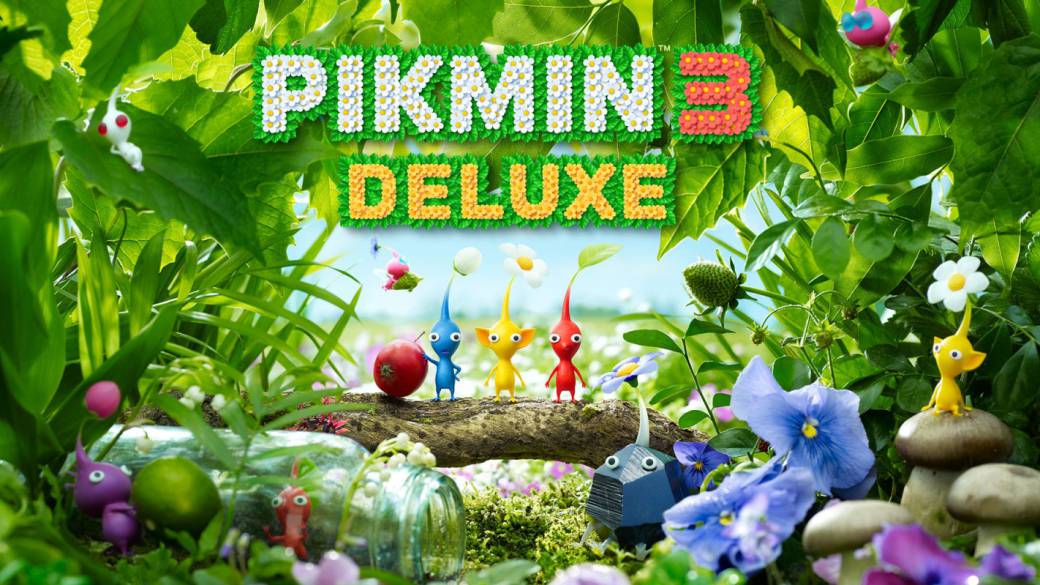
Another of the highlights of Wii U makes the leap to Switch. And with it come both some news and the same quality as always.
There are basically two ways to tackle Pikmin 3 Deluxe. And by this we do not mean as a novelty for those who missed its original premiere on Wii U or as a port for those who already have said version and now consider going back to the Switch. Good, too. We will have to talk about that. But first we will enter into another relevant distinction for both types of users, according to which the recommendation – or not – is probably made alone. One that deals with design, the nature of its objectives and its hypothetical longevity, especially once we add the unpublished content of this edition, which is there and deserves its own section.
Before that, they would normally play the presentations, although here it may not be so necessary because the Nintendo saga has already gone through three company consoles – four if we count the 3DS spin-off -, in addition to occupying a deserved place in Smash Bros. for years. If it was still necessary, you can always take a look at the preview of this month, where we walked the previous path, discussing its predecessors and the contributions that they bequeathed to the third part. And for the lazy clicking links, we will also add that the series is a combination between adventure and strategy, that in it we handle tiny astronauts, we cultivate hundreds of plant-bugs (Pikmin) and we use them both to subdue the rest of the local fauna and to get or retrieve objects of importance that are transported to the ship — astronauts do not get their hands dirty. Voucher? Well come on, to the mess.

The Astronauts: Lost, But Just A Little Bit
Just as Mario and Zelda rarely break their heads when it comes to raising a plot starting point that, moreover, has its parallels despite the gender change (“the villain has kidnapped the princess, oh no!”), Pikmin tends to coincide a lot with Metroid: we arrive at a planet —which in Pikmin’s case is always the same, ours, although we visit different parts so as not to repeat designs— and the landing is rough, so the first objective is to recover, learn to use available skills to solve any initial problems — which in this case are external to the characters — before setting more long-term goals.
Note that it is not so much a complaint as an appreciation, because almost everything of value that these sagas build occurs in the spaces between sequences and dialogues. Those in which the player is the conductor. Thus, when Alph, Britanny and Charlie, the three crew members of the Drake ship, end up scattered around different parts of the planet, the objective is not so much to create drama as to propose a dynamic start, where they become familiar with the basic mechanics and properties of different types of Pikmin in short segments before the game brings them together and adopts the time-trial structure that from the first installment defines the saga.
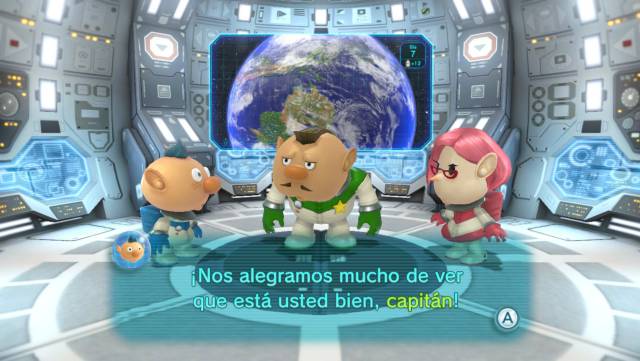
That’s where things get interesting, and where we return to the topic with which we open the Reviews. Because Pikmin 3, more than any of the previous installments, soon marks two parallel tasks, interconnected, but of a somewhat different nature. The first, which we could define as the main development, is the one that pushes us both to put the three astronauts together and then to get certain parts for the ship, unlock and explore the five great regions into which the game is divided, find and familiarize ourselves with the also five types of Pikmin available – fire resistant, electrically conductive, flying, aquatic, etc. -, cross our path with that of characters from previous installments and, finally, leave the planet safe and sound (sorry if anyone believed that Nintendo was going to canonically kill its protagonists and considers that revelation a spoiler).
The Pikmin: Cannon Fodder
That does not mean, of course, that death is a very present aspect in Pikmin. Our astronauts are rarely in real danger, but their troops of colorful creatures are another story. Growing hundreds of them – carrying the corpses of enemies or colored pills that sprout in flowers to their onions of origin – responds to the need to transport heavy objects, distribute them in groups to fulfill several simultaneous tasks or use more force when we launch a squad towards a rival of a certain size, but also to the reality that, at least in the first game, we will surely lose a considerable number of Pikmin. Dozens and dozens, who will emit painful groans as they vanish in the form of ghosts so that we feel remorse for our incompetence.
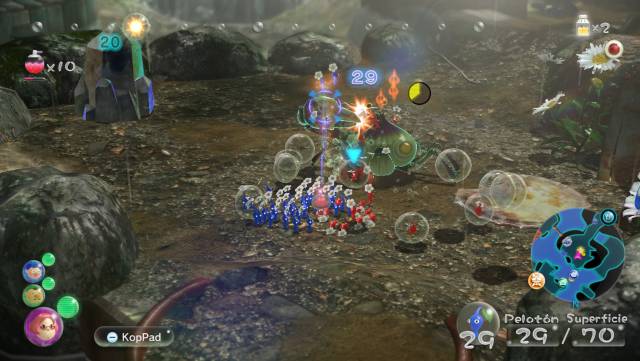
That said, the game isn’t too tight either. Although this time it makes a distinction between normal and hard mode, we recommend choosing the second mode directly – equivalent to the only one on Wii U – even if you have no previous experience. Aspects such as the practical focus on objectives or the discarded reversion of the Flower Pikmin to Leaf Pikmin due to the damage already smoothed things out in the original edition, but Deluxe also distributes more eggs with yolks that evolve into the Pikmin on the scenarios – the versions with flower on the head are faster and more powerful -, considerably increases the radius of the whistle that calls them and even allows interrupting the tasks of all Pikmin from the Drake so that they go and not be prey to the nocturnal beasts when the daily counter reaches its end and the exploration is interrupted until the next morning.
To that we can also add a new system of tracks and optional arrows that mark the route to the next main objective on the ground. Small adjustments separately, but added together, give Deluxe a friendlier and more comfortable character, where errors, more than ever, are the responsibility of the player, who can still misjudge the time it takes to perform some tasks, lose sight of groups that are attacked while carrying objects or being surprised by some kind of new enemy whose routines or weaknesses you have not yet become familiar with. The epitome of this are the bosses, high points of development due to their variety and to pose fights that sometimes require almost a full day, but which turn out to be quite affordable fights as soon as we find an ideal method to defeat them through the use of logic. or a bit of trial and error.

Tick, tock: Fruits, puzzles and hourglasses
Purists may find some of the new concessions unnecessary, but it’s also easy to see Deluxe as just as or more representative of the “Nintendo philosophy” than the original Pikmin 3. By this we mean that renewed kindness contributes to lowering the skill level required to complete the story, but it also encourages more not to stay in that superficial aspect. Returning to the idea of the two parallel tasks, intertwined with the main development is a search for fruits that, although not entirely optional, does open wide the range of player options when deciding the order and the number of tasks that you will participate in during or even after the path towards more credits.
In the same way that, for example, a 3D Mario can set a goal to get 60 or 70 of the 120 available stars and then give carte blanche, Pikmin 3 distributes dozens of fruits around its areas that, once transported to the ship, they become provisions to extend the number of days we can stay on the planet. Taking into account that every day it falls below 20 minutes in real time (18 in normal mode; 13 in difficult, like Wii U), the initial amount of provisions is completely insufficient and during the first bars getting fruit is, in fact, more important than following the theoretical main development. A momentary rush, but useful to highlight the importance of multitasking, since getting these fruits requires not only walking to find them, but using the Pikmin to tear down walls, build bridges carrying small tiles, dig for bombs with which to destroy more resistant obstacles or use the specific properties of each type.
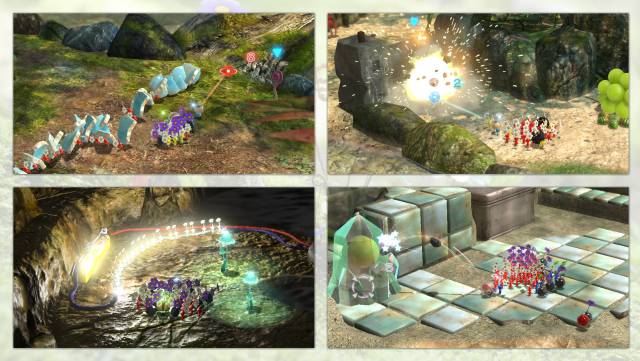
Because, just as Pikmin 3 – original or Deluxe – can be a kinder game in the small nuances, it is also one with larger maps, which branch out in more directions from the landing point of each zone. This, together with the short waiting time that many of these tasks usually entail, invites us to divide into two or three groups, each one commanded by one of the astronauts, to explore in turns – or simultaneously if we play in the new cooperative – different areas and make more efficient use of that quarter of an hour that we have. The design itself is sometimes in charge of requiring division, posing obstacles that can only be overcome if one of the astronauts throws another like Pikmin, or several puzzles based on scales that require playing with the weights of the platoons, although by rule it is more a resource to optimize than an imposition.
As Pikmin 3 relieves the pressure for time and allows you to focus on the strictly necessary objectives – to the point, the adventure can be completed in less than 10 hours – in parallel it also opens and offers a kind of “sandbox” of strategy. There comes a point where picking fruit is no longer necessary, but doing so means discovering new zones – often going back to take advantage of its metroidvania side -, finding optional mini-bosses, and tackling challenges where the design requires deep thought about how many each type of Pikmin we carry – up to a cumulative cap of 100 – or how we distribute them among the astronauts. Something that not infrequently requires waiting for the next day after doing an examination. Only in this way can we get all the fruit and unlock the best ending, making those 10 hours turn into 15 or 20 hours with the potential for some of the last to also be among the best.
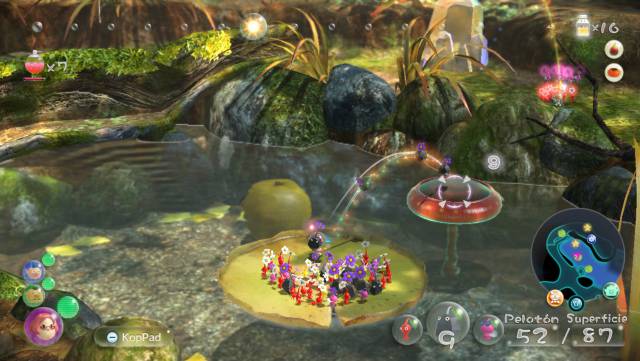
Deluxe Missions: The Return of Olimar (and Luis)
Of course, the fact that they are among the best depends a lot on what each player is looking for in Pikmin 3. Or in other words, to what extent the enjoyment of its peculiar playable loop is linked to the challenges posed by the design, the arrangement of enemies and the impositions of time or, on the other hand, need other stimulants in the form of a narrative progression – albeit a simple one – and a geographical one through new scenarios. It is an even more important dichotomy when we jump to the extra content, which not only recovers all the Wii U missions -including the paid ones-, it also adds a good handful with Olimar and Luis that serve as parentheses by dividing up two sets located before and after the main story.
As we already advanced in the advance, these missions are just that, missions. Which means there isn’t that day-to-day continuity of the normal campaign, where cultivated Pikmin are kept or objectives can be left half-way and returned to complete them the next morning. Although, unlike the rest of the missions, there is a common thread, especially in the second part, unlockable after passing the game. While the prologue missions are limited to taking advantage of the Olimar recordings already seen on Wii U, the epilogue is longer and more elaborate, with greater variation of objectives level after level: instead of simply accumulating profits against the clock, sometimes we have to recover pieces of the ship – opening and securing the path -, explore different parts of the same level with Olimar and Luis, or traverse from end to end an area full of enemies and walls before time runs out.
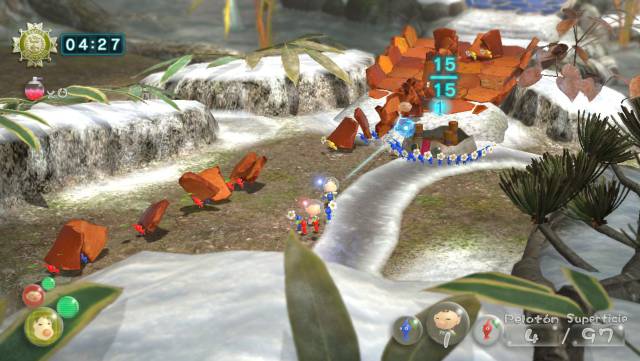
Although there are hardly any new sequences as such, each of these missions is introduced through Olimar’s diary which, as in the previous installments, narrates his objectives, difficulties and the always disturbing behaviors of Luis. On the other hand, the reuse of scenarios and enemies is constant, although the study, we believe, has done a good job segmenting and altering some areas, which sometimes require a lot of attention to identify where in the game they were originally: new obstacles, appearance of enemies outside their habitat, emptying of rivers, etc. Competent, but surely not very stimulating for those who expected more substantial news such as new locations or bosses.
To buy back or not to buy back, that’s the question
Going back to the beginning, is Pikmin 3 Deluxe worth it then? For a player who has skipped the previous version, our answer is a resounding yes. The game was counted among the best of the Wii U repertoire and its virtues are still valid today. Even running through his campaign and not taking advantage of all the possibilities, his dense and exquisite design halfway between adventure and strategy, the satisfaction of solving his puzzles and bosses or the precious artistic direction – which still works hard to counteract a geometry of scenarios to sometimes a little low — they reintroduce it to the Switch catalog as a new standout. With the jump, of course, portability is added that lowers the resolution somewhat, but remains perfectly enjoyable thanks to good image quality, stable performance and exemplary adaptation to the controls – even if you do not use the touch screen.
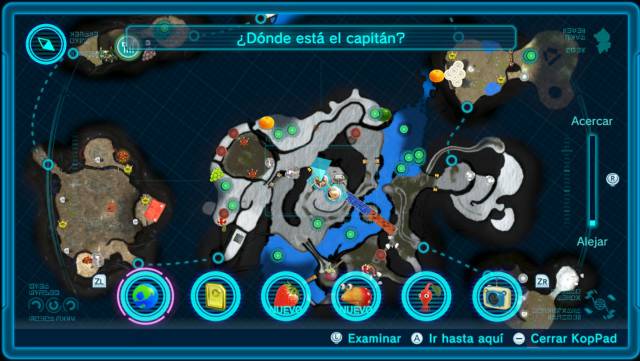
On the other hand, the multiplayer mode is also released in the campaign – in addition to continuing, of course, in the missions or the competitive bingo battles -, the Piklopedia with enemy data, an achievement system, the possibility of saving three games in the same profile – it was missed on Wii U -, the unlocking of an extra super hot mode – with tougher enemies and a limitation to 60 Pikmin – and various refinements in mechanics such as targeting or loading and launching Pikmin . Along the way, the possibility of using the Wiimote – although the Joy-Con supplies it quite convincingly – and the dual screen of the Wii U – which means that now the map works as in Pikmin and Pikmin 2 – have remained, but they are minor details next to what you earn.
Pikmin 3 Deluxe, therefore, lives up to its new subtitle and presents improvements on almost all fronts, although on a technical level more benefit could have been from the revision, it is simple port and does not offer significant improvements in dock mode, where it definitely does not rub shoulders with the best exponents of Switch. That, and the potential disappointment with the new content approach, may be a hindrance for some to shell out full price again. The recommendation continues to be extended to veterans, be it for the quality of the game as such, for portability or for multiplayer. But it definitely has an asterisk next to it so that everyone considers what they expected or wanted from the new version.
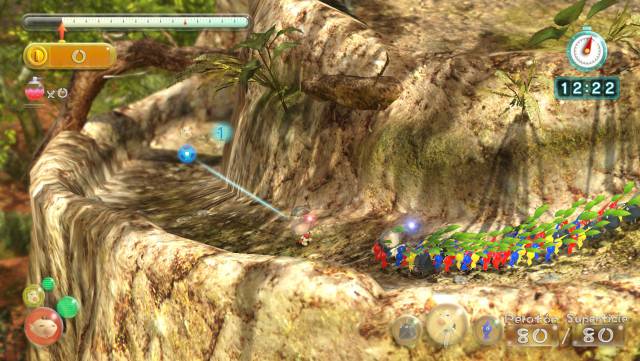
CONCLUSION
Pikmin 3 makes the leap to Switch with an edition that offers several and important improvements. Deluxe fits into the Nintendo hybrid almost as if it had been created for it, taking advantage of its portability and its multiple control methods, to which it adds some refinements, the valuable option of cooperative in the story mode and several extra missions with Olimar and Luis to extend a game that already on Wii U could last quite a few hours to the most minute ones. Despite the years since its release, there is no other game that offers the same, so it is still an easy recommendation. However, while the studio has generally done its homework, on a technical level it has lagged somewhat behind and the unreleased content offers little really new. More suitable for newbies than veterans, although everyone can benefit from it.
THE BEST
- Cocktail of genres with exquisite design, remains current.
- The implementation of the cooperative in the story mode.
- Multiple playable refinements over Wii U.
- The addition of the Piklopedia and the super hot difficulty.
- Abundant bonus content when adding the DLC missions and the unreleased ones.
WORST
- Olimar and Luis’ mini-campaign brings little new.
- Technically there is room for improvement in details such as resolution and geometry.
Very good
A game with a remarkable finish that we will enjoy and remember. A good buy, highly recommended for lovers of the genre. It is well cared for at all levels.
